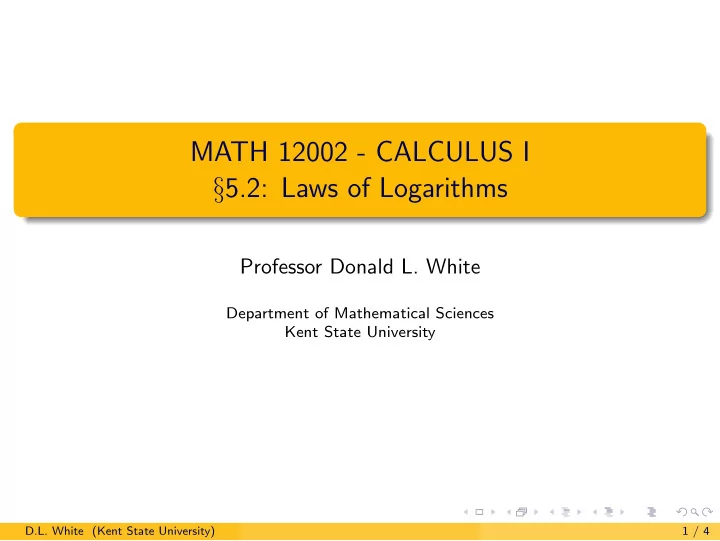

MATH 12002 - CALCULUS I § 5.2: Laws of Logarithms Professor Donald L. White Department of Mathematical Sciences Kent State University D.L. White (Kent State University) 1 / 4
Laws of Logarithms The familiar Laws of Logarithms all follow (directly or indirectly) from the fact that dx ln x = 1 d x . Laws of Logarithms Let a and b be positive real numbers and let r be any real number. 1 ln( ab ) = ln a + ln b 2 ln 1 b = − ln b 3 ln a b = ln a − ln b 4 ln( a r ) = r ln a D.L. White (Kent State University) 2 / 4
Laws of Logarithms Proof: 1 Let f ( x ) = ln( ax ), for a positive constant a . dx ln x = 1 d Since x , we have by the Chain Rule f ′ ( x ) = 1 ax · a = 1 x . Hence f ( x ) and ln x have the same derivative, and so f ( x ) = ln x + C for some constant C , i.e., ln( ax ) = ln x + C . But this holds for all x > 0, in particular for x = 1, so ln a = ln( a · 1) = ln 1 + C = 0 + C = C . Hence C = ln a , and so ln( ax ) = ln x + ln a = ln a + ln x . Substituting b for x gives ln( ab ) = ln a + ln b . D.L. White (Kent State University) 3 / 4
Laws of Logarithms [Proof, continued] 2 We have 0 = ln 1 = ln b · 1 b = ln b + ln 1 b by (1), and so ln 1 b = − ln b . 3 We have ln a b = ln a · 1 b = ln a + ln 1 b = ln a − ln b by (1) and (2). 4 Let f ( x ) = ln( x r ) for x > 0. As before, f ′ ( x ) = 1 x r · rx r − 1 = r · 1 x = d dx ( r ln x ) , and so r ln x = f ( x ) + C = ln( x r ) + C for a constant C . If x = 1 this becomes r ln 1 = ln(1 r ) + C , or 0 = C . Hence ln( x r ) = r ln x , and substituting a for x gives ln( a r ) = r ln a . D.L. White (Kent State University) 4 / 4
Recommend
More recommend